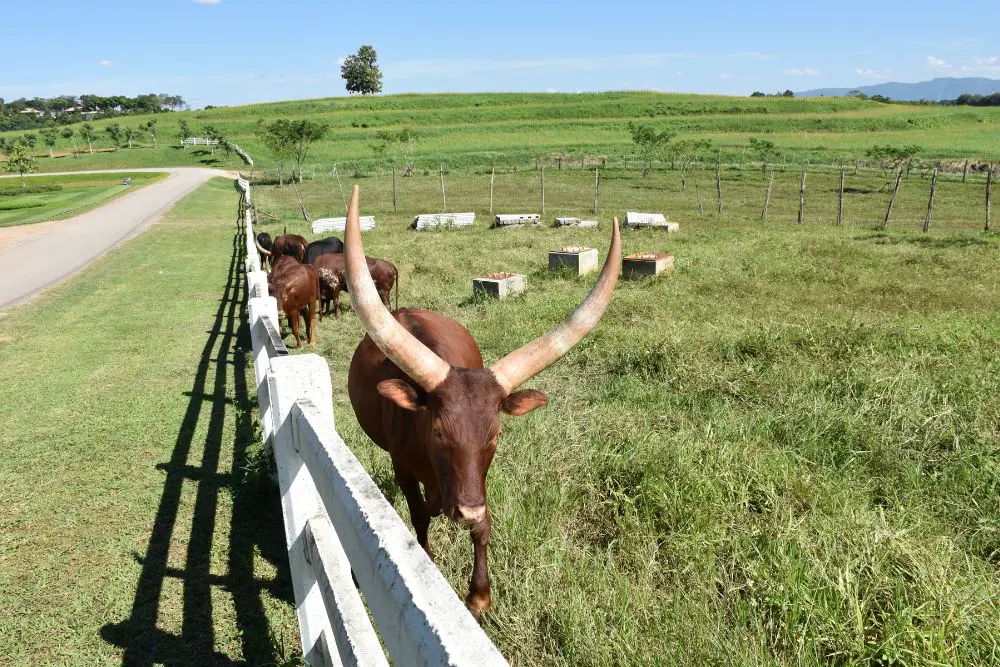Watusi cattle are known worldwide as having the most magnificent horns of any longhorn breed of domestic cattle. They are a highly adaptable, drought-resistant breed from East Africa that produces excellent milk quality with a high-fat percentage.
Today they are a rare breed, though conservation efforts have commenced on reviving their dwindling population on different continents.
Table of Contents
Where Does Watusi Cattle Come From?
Watusi cattle are an ancient breed of bovine with a long history.
They played an important part of East African culture and commerce as long as 2000 years ago when the Sanga type of cattle was created by crossing the Egyptian Longhorn with African Zebu cattle. The Sanga then went on to produce several distinct varieties of cattle including the Watusi.
Watusi cattle go by many names including Royal Ox, Ankole cattle, and Cattle of Kings, and were primarily located in Uganda, Rwanda, and Burundi originally.
Cattle were often named after the tribe raising them. Watusi was the name for the Tutsi tribe who lived in Rwanda and Burundi while other regions in Eastern Africa called them Ankole, Kivu, Bahima, and others, naming them after local tribes.
Watusi were considered sacred and rarely slaughtered. They symbolized wealth and provided status within the tribes and were often used for their rich milk.
However, their population remained consistently small despite their local popularity.
Conservation of Watusi Cattle
Watusi were first exported in the 20th and 21st centuries to different continents including North America, South America, Europe, and Australia where herds were established through breeding programs in an attempt to revive the dwindling population of the Watusi breed, who had caught the eye of farmers and conservationists.
They were first brought to America in the 1960s and breeders knew they needed to use an up breeding program to revive this breed that was slowly disappearing.
Their efforts over several generations were fruitful and they were able to achieve 7/8 blood for cows, and 15/16 blood for bulls by using various Canadian and American breeds including the Texas longhorn which offered the closest characteristics to purebred Watusi.
Today, 80% of the roughly 1500 registered Watusi cattle left are in the United States.
The Ankole Watusi International Registry and World Watusi Association are entities that publish standards for the breed, offering registry and pedigrees. Their efforts continue to promote the breed and offer the public a way of obtaining breeding stock.
Watusi Cattle Breed Characteristics
| Official Breed Name | Ankole-Watusi Cattle |
| Scientific Name | Bos taurus indicus |
| Origin | East Africa |
| Appearance | Dark red with some white speckling is the most common color type They can also come in shades of brown, gray, dun, or yellow They have incredibly long lyre-shaped horns Has a small neck hump, long legs and a long tail |
| Calf Weight | 30lbs to 50lbs |
| Mature Cow Weight | 800lbs to 1200lbs |
| Mature Bull Weight | 1000lbs to 1600lbs |
| Ready To Breed | 13 to 15 months |
| Gestation Period | 279 days |
| First Calvings | 2 years |
| Time to Slaughter | 6 to 9 months (though rarely slaughtered) |
| Expected Lifespan | 20 years |
| Productive Lifespan | 10+ years |
| Known For | Large horns, drought resistance, adaptability |
| Weaknesses | Generally cannot be used for beef production due the sacred nature of this breed |
| Climate | This breed of cattle does exceptionally well in hot climates and have a great deal of adaptability to temperature extremes |

What Is So Special About Watusi Cattle?
Watusi cattle have incredible, long horns that are set wide apart on the head and curve upwards in a lyre shape. Their horns hold the record (40.7 inches) for the longest horn circumference of any domestic cattle breed in the world.
These horns are not only impressive to look at, but serve the purpose of lowering body temperature through excess heat dispersal in hot climates.
Watusi cows are able to produce nutritious, butter fat enriched milk (10%) for their calves even in poor feed conditions which offered an evolutionary survival advantage in Eastern Africa. The lactation period of cows after calving is 305 days.
Newborn calves are nimble and vigorous within hours of birth, though they are somewhat small.
Watusi cattle stick close together and offer protection for one another. Calves sleep inside a circle of Watusi cows, who display their horns facing outward, to warn off potential predators.
Why Should I Raise Watusi Cattle On My Farm?
- Ability to digest poor quality and quantity of feed and still thrive
- Extreme hardiness against parasites, fluctuations of temperature, and water conditions
- Breeding stock is obtainable because of the efforts of the Livestock Conservancy, European zoos, and official registry organizations
- Docile, relatively easy to handle breed who are highly social
- They can be successfully utilized in crossbreeding programs for first-calf-heifers of other breeds due to low calf size
- While not traditionally used for meat production, Watusi meat is lean and has low-cholesterol
